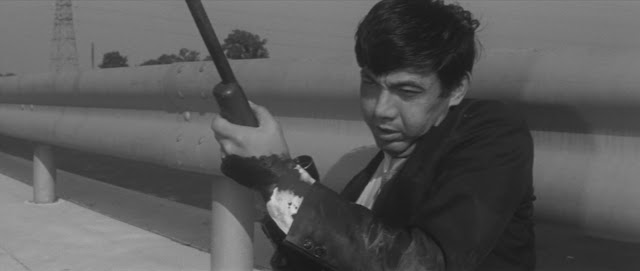[NOTE:
Since a few days ago I posted about how related the particular mood of this film was to the worlds of the Giallo and Krimi, I thought I’d also post a brief write-up. This is the eleventh in a series of reviews that will focus on
genres related to the Krimi and Giallo; for more info, read this post. As with all posts on this site, SPOILERS SHOULD BE EXPECTED.]
[GENRE]: Neo & Noir [>exploitation]
[VERSION WATCHED]: Arrow Video Blu-ray
Before my cinematic world got swallowed by all things Italian, German, and Eurocult, my first serious gateway into movies—into movies being a real *thing* in my life—was the work of a half dozen or so Japanese directors:
Seijun Suzuki (esp. YOUTH OF THE BEAST and BRANDED TO KILL); Shôhei Imamura (VENGEANCE IS MINE and THE PORNOGRAPHERS); Yasuzo Masumura (MANJI, and the Yukio Mishima-strutting AFRAID TO DIE); Koreyoshi Kurahara (THIRST FOR LOVE and THE WARPED ONES); Hiroshi Teshigahara (FACE OF ANOTHER and PITFALL); and, though it’s true his filmography is congenitally uneven, Takashi Miike (putting Lynch’s LOST HIGHWAY into a Japanese blender and getting GOZU; also the performance he gets from the lead in his remake of GRAVEYARD OF HONOR).
It’s been a while since I’ve seen a Japanese movie that reminded me how I felt watching the work of those formally innovative, ero-guro-tinged (sometimes not just tinged, but *drenched*) directors. Watching Yasuharu Hasebe’s MASSACRE GUN gave me just that reminder. Partially, I’m sure, because he worked under Seijun Suzuki for part of his career, but more because his film manages to do what so many noir-influenced Japanese films of the 60s did: to marry flawlessly composed black-and-white, with noir nihilism, with a particular sense of that country’s tradition (notions of “honor” and “brotherhood” that get pushed to the point of self-destructiveness) with a nightmarish, ero-guro violence that one-ups and perfects everything else.
Though maybe not as off-the-charts bizarre (nor transgressive) as something like BRANDED TO KILL, MG still satisfies on the same levels.
The movie opens with a mostly wordless five-minute prologue where we watch Jô Shishido (literally the chipmunk-cheeked face of this genre for so many years) get pressed into self-destructive service: his yakuza boss orders him to murder the woman he loves (who certainly loves him). It’s wrenching in the sense that S.’s face shows us the inner turmoil he’s struggling to keep swallowed. Wrenching because when he goes to pick her up, she is blissfully happy in his arms, in the mistaken belief that they will be escaping by plane from this price on her head. Wrenching because the murder when it happens twists everything around in the scene so quickly—her joyous face contorted by the terror of the gun; the sudden burst of action that changes the contemplative, jazzy pace so far (S. leaps from a car containing her body as he drives it into a lake).
This scene cuts to the club Shishido runs, introducing us to Ken Sanders, whose deep-throated singing of a wordless dirge not only comments on Shishido’s headspace in the previous scene, but cues us for the tone of the rest of the movie. What follows is a series of gangland power plays that increase in intensity and offensiveness. And that show how hopeless any opposition to the yakuza's grip on society is (note how the focus on Sanders hands delicately playing the piano is repeated with the focus on the FISTFUL OF DOLLARS-like mutilating of a boxer’s hands by a rival gang).
- Shishido’s friend-in-the-uprising being delivered to his club in a casket (complete with hidden ticking time bomb tethered to his corpse);
- the erotic (and surprisingly modern-feeling) floor show at S.’s club, where a barely dressed man and woman do interpretive dance that could just as easily belong in an art film on another continent;
- the way S.’s surgically enhanced cheeks suck on a cigarette when he gives orders like a boss;
- a tense conversation between man and wife, shot upside down and in the reflection of a bar counter;
- a sudden skewer through the finger;
- an extreme long shot showing two people silhouetted by enormous sky, walking as they talk through their unfixable relationship;
- a rusted-out cargo ship used as the site of a gangland trap whose litany of guns give it strobe-lighting;
- even the boat scene that references the “youth in revolt” movies.


Shishido proceeds in “battle-damaged” mode, stalking his final opponent (his one true “brother,” who’s been forced by his gang affiliations to break ties and hunt S. down), circling around each other’s gun, drawing beads on each other on this impossibly abandoned highway—it’s really something. And recalls, more than once, that long sequence in BRANDED TO KILL when Shishido drags himself beneath a car (tied to a rope no less) in order to use the car as cover from the snipers trying to kill him.
It adds up to a hyper-violent, weird climax to what’s been, up till then, a noir mood piece. Def. looking forward to seeing more of Yasuharu Hasebe's work.
Leonard Jacobs
July, 2015

























Finally managed to catch up with this. Stunning stuff. The more Nikkatsu films I see, the more I want to see.
ReplyDelete